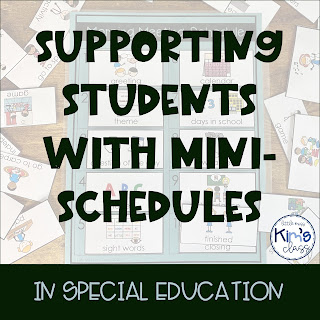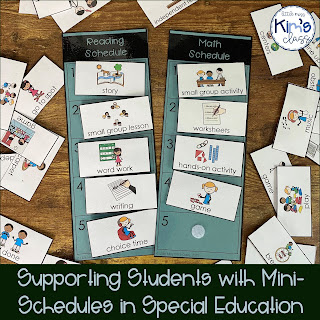Have you tried mini-schedules (AKA activity schedules) in your classroom yet? They are an AMAZING way to break down activities/ schedules and support students.
Mini-schedules are basically mini-task analyses for specific activities in the schedule. When you think about your entire daily schedule (i.g. breakfast, morning meeting, reading groups, math, etc.), you can break down each of those times with mini-schedules!
There are many reasons to implement mini-schedules and numerous ways to use and create them. They can be used to support students with a variety of needs and in a variety of settings!
Why use mini-schedules?
- to support students with on-task behavior/ completing tasks
- to encourage consistency of routines for staff and students
- to increase independence and self-management skills
- to create smoother transitions between activities
How to use activity schedules:
- Start by breaking the specific task down into steps. Make sure to include the individual steps in the activity but also remember that this will look different depending on the student(s) you're making the mini-schedule for. The key is differentiating and knowing your students' needs! Think about the different changes that might be needed for the morning work mini-schedule below:
- One student might need the mini-schedule pictured,
- while other another student might just need the mini-schedule to have: 1) Get work. 2) Go to spot and start working.
- Get the schedule in writing and/or pictures. Again, this step will depend on your students' needs. Keep reading for different types of activity schedules and ways to create them!
- Put the schedule in a space where it's visible to students and staff.
Types of activity schedules:
Turns out the theme of mini-schedules is to differentiate based on your students' needs :-P The amount of text/ pictures and the number of prompts you include in each activity schedule will depend on your students.
- Written mini-schedules:
- Written mini- schedules are great for students who are able to read text and don't need picture visuals. You can simply write the mini-schedule on a whiteboard or piece of paper. You can also laminate small written mini-schedules and put on folders/ binders. There are so many options!
- Picture mini-schedules:
- There are also tons of options for creating activity schedules with pictures! They don't need to be super fancy or elaborate. I sometimes just write activity schedules out and add some hand drawn pictures (I know I'm not an artist!).










No comments:
Post a Comment